Call emergency services
What is an AED? Everything You Need to Know and More
- What is an Automated External Defibrillator?
- What is sudden cardiac arrest?
- Automated External Defibrillator – how it works
- Training to use an Automated External Defibrillator
- How to use an Automated External Defibrillator – a step-by-step guide
- AEDs and the law
- Choosing an AED
- Installing an AED
- Maintaining an AED
- AEDs in schools
- The National Defibrillator Database
What is an AED? Everything You Need to Know and More
Reading time: 12 minutes.
What you need to know
AED stands for Automated External Defibrillator. This equipment is used to treat people who have had a sudden cardiac arrest outside of hospital.
In the UK this happens to around 30,000 people each year. NHS records show that only around one in five of them survive. However, their chances improve dramatically if emergency treatment is provided as soon as possible.
Almost half will be successfully resuscitated when defibrillation is given in the first four minutes, so defibrillators in public places and at work can save lives. However, for every minute it takes for a defibrillator to reach someone and deliver a shock, their chances of survival reduce by up to 10%.
Should my business have an AED?
There aren’t any laws requiring defibrillators in the workplace, but the Institution of Occupational Safety and Health (IOSH), the British Heart Foundation and the Resuscitation Council UK recommend that they are available.
The Health and Safety Executive (HSE) recommends that businesses should have defibrillators if their first aid needs assessment indicates that they are required.
Some businesses choose to have defibrillators because they want to show their commitment to keeping their employees and the local community safe.
If you’re unsure about first aid requirements in the workplace, our guide to first aid in office facilities may be of interest.
What you will learn in this guide
You will have a clearer understanding of the meaning of ‘sudden cardiac arrest’ and how an AED can help to restore a regular heart rhythm which could keep someone alive until medical help arrives. While special training is not needed to use an AED, their use is now included in First Aid at Work and Emergency First Aid at Work training.
While AEDs aren’t required in the workplace, a first aid needs assessment might indicate that they should be installed.
Installation and maintenance of AEDs is straightforward. Making sure people nearby are aware of the location of an AED could help to save someone’s life.
What is an Automated External Defibrillator?
An Automated External Defibrillator or AED is a lightweight, battery-operated, portable device used to help people having sudden cardiac arrest (SCA). The AED checks the heart’s rhythm and, if needed, sends a shock to restore a normal rhythm.
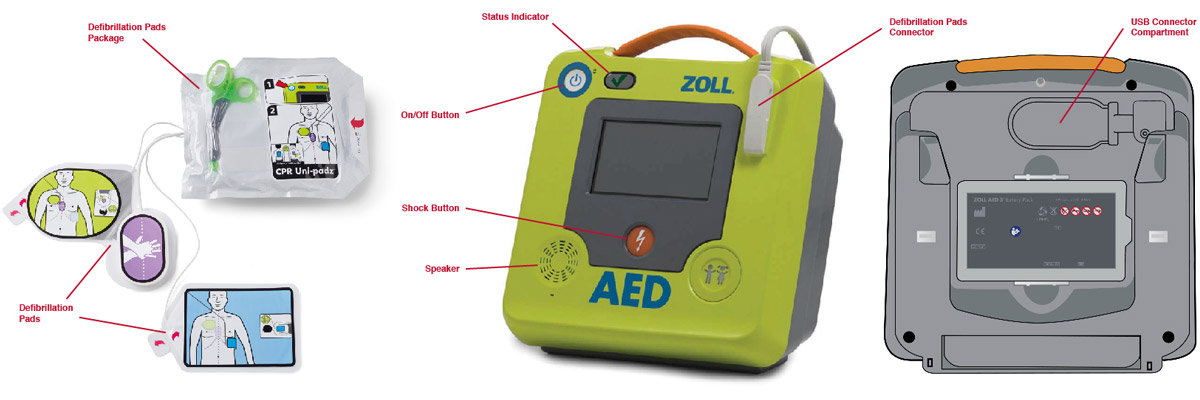
Sticky pads with sensors (electrodes) are attached to the chest of someone who is experiencing SCA. The electrodes send information about the person's heart rhythm to the AED. The AED analyses the heart’s rhythm to find out whether an electric shock is needed. If needed, the electrodes deliver the shock.
You can see a short video from the British Heart Foundation here:
What is sudden cardiac arrest?
When the heart suddenly and unexpectedly stops pumping blood around your body it is known as sudden cardiac arrest (SCA). If this happens, blood stops flowing to your brain and other vital organs. People can die within minutes if they don’t receive treatment.
Electrical impulses in the heart control the rate and rhythm of your heartbeat. Most cases of SCA are due to an abnormality of the heart’s electrical rhythm called ventricular fibrillation (VF), in which the electrical impulses become chaotic and uncoordinated. This causes irregular heartbeats called arrhythmias. The heart can beat too fast, too slow, or with an irregular rhythm.
SCA is not the same as a heart attack, which is when blood flow to part of the heart is blocked. If this happens, the heart doesn't usually stop pumping blood around your body. SCA, however, may happen after or during recovery from a heart attack.
People who have heart disease are at higher risk of SCA, although it can happen in people who seem to be healthy and have no known heart disease or other risk factors.
Back to indexAutomated External Defibrillator - how it works
A quivering or irregular heartbeat is called ‘fibrillation’. One of the most effective ways to return a heart to a normal rhythm is with a defibrillator.
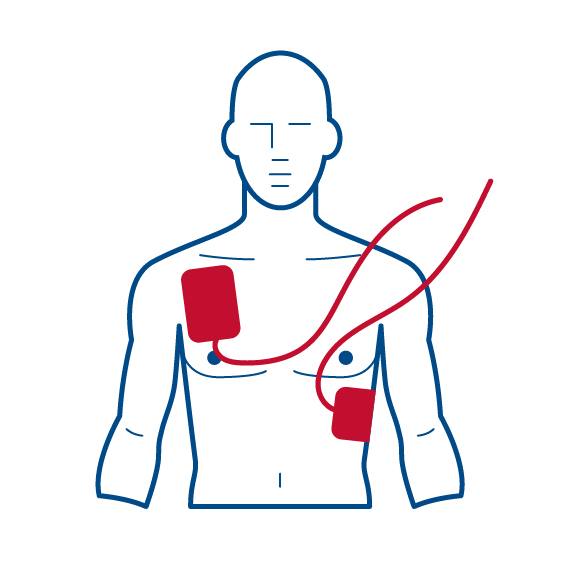
A defibrillator sends an electric shock to the heart to restore a normal rhythm and circulation of oxygenated blood around the body.
AEDs are important, because you don’t have to be a trained professional to use one. Normally an AED has step-by-step instructions and voice prompts that allow an untrained bystander to use the machine correctly. The AED’s diagnostic program interprets the heartbeat and will only deliver an electric shock if an irregular heart rhythm is found that requires defibrillation.
AEDs can be used for adults and for children as young as one year old.
Back to indexTraining to use an AED
The Resuscitation Council UK guidance says that AEDs are safe to be used by untrained bystanders.
Public AEDs are becoming more common and there are national strategies to promote them in schools and public places such as stations. Many workplaces have voluntarily invested in them.
AEDs in the workplace aren’t required in health and safety legislation. However, if your first aid needs assessment indicates that they should be provided, then the Provision and Use of Workplace Equipment Regulations 1998 (PUWER) will apply.
To comply with PUWER you should provide information and written instructions on how to use it. The will often be provided by the manufacturer.
Training isn’t required but is likely to make your employees feel more confident. Training in the use of AEDs is now included in the syllabus for First Aid at Work (FAW) and Emergency FAW.
Back to indexUsing an AED – a step-by-step guide
Apply CPR
Find nearest AED
Use AED
Await medical help
If someone appears to have SCA then 999 should be called straightaway and the nearest AED should be identified. Chest compressions alternated with rescue breaths, known as cardiopulmonary resuscitation (CPR)*, should be given. When the AED is brought to the scene there are a number of simple steps to follow.
| Step 1: | Turn the defibrillator on by pressing the green button. |
| Step 2: | Follow the instructions to connect the sticky pads to the person’s bare chest, one on each side, as shown in the picture on the defibrillator. The AED can monitor the patient’s heartbeat through the pads to confirm whether there is a viable, shockable rhythm. An AED is very safe because it will only charge if a shockable rhythm is present. |
| Step 3: | If a shock is to be given the AED will charge in preparation. |
| Step 4: | When charged, it will tell you to make sure that no one is touching the patient. You will have to stop CPR and move away. You will then be asked to press a button to deliver the shock. Fully automatic AEDs will tell you that they are about to deliver the shock, and won’t any further intervention. |
| Step 5: | The AED will tell you when the shock has been delivered. It will instruct you to continue CPR for two minutes, and then it will analyse the patient’s heart rhythm again, advising you if a further shock or CPR are needed. |
Diagnostics - An AED has internal memory which stores an ECG or electrocardiogram of the person’s heartbeat, along with details of the time the unit was activated, and the number and strength of any shocks delivered. This information can be downloaded to a computer or printed out, so that it can be analysed by medical personnel.
*For details see the Adult basic life support and automated external defibrillation guidelines.
Back to indexAEDs and the law
In the USA ‘Good Samaritan’ laws protect people who help others, but the UK doesn’t have a similar law.
English law says you would only be liable for harm if it could be shown that your actions left someone in a worse situation than if you hadn’t done anything. In the case of SCA this is very unlikely.
No cases have been successfully brought against anyone who has provided first aid.
Back to indexChoosing an AED
Most AEDs are designed for basic-level responders who don’t need to be specially trained. Some have additional features like ECG screens, but these aren’t needed at this level.
Your local ambulance service might provide recommendations, based on compatibility with the models they use.
Important differences between models that should be considered include the:
- cost of buying the AED
- cost and shelf-life of batteries
- cost and shelf-life of the electrode pads
- duration of the manufacturer’s guarantee
- after-sales services.
The British Heart Foundation can recommend suitable products and might help with costs if you are happy to make the equipment publicly available. You will be encouraged to speak with your local ambulance service, which can consider supporting your application.
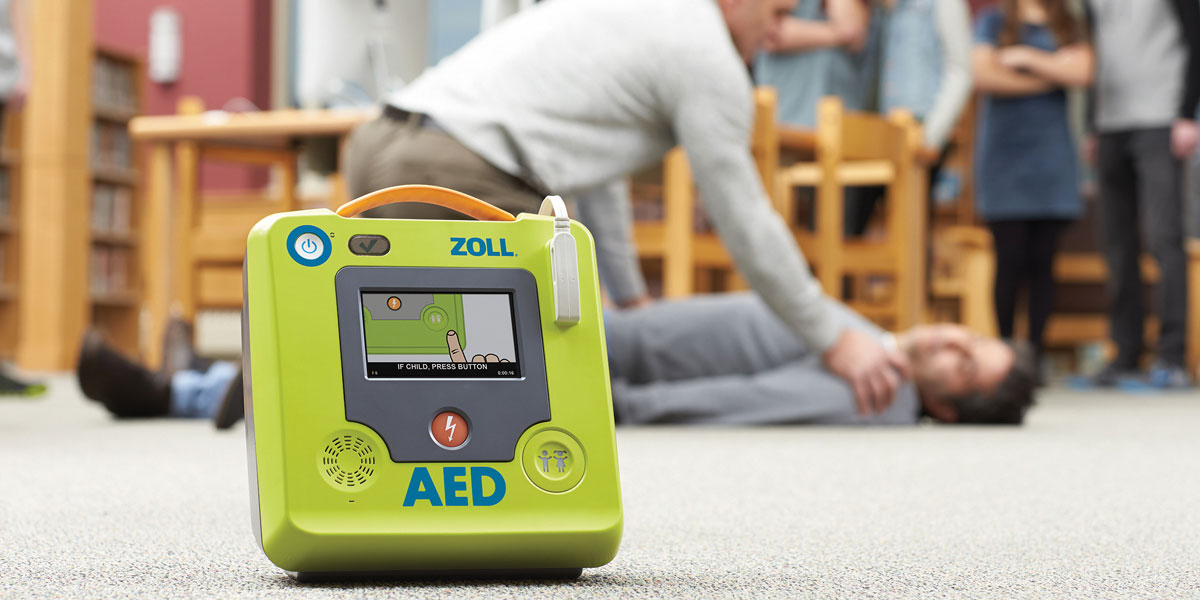
Installing an AED
The most important consideration is that anyone who might need to use an AED knows where it is kept and how to access it quickly. No barrier should be put in the way of anyone collecting it when it is needed; ideally it should not be locked away.
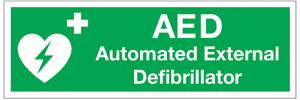
A standard sign for an AED should be used to show where it is stored.
Various types of cabinet are available offering different levels of security and weather-proofing. With many, the door is alarmed so that when the AED is removed it is activated; local circumstances will highlight whether this feature is needed.
Although AEDs don’t need power themselves their cabinets are often heated to keep the equipment at the right temperature and to provide a light inside when the door is opened.
Some AEDs have a mains-charged battery to make sure they will still have power if there’s an interruption to the supply.
AEDs should be as close as possible to their most likely place of use. This might depend on the layout of the building or venue and the number of people who might be at risk. Security might be a consideration.
Back to indexMaintaining an AED
AEDs need very little routine maintenance or servicing. Most carry out daily self-checks and display a warning light if they need attention. Most have a minimum life-expectancy of ten years. The batteries and pads have a long shelf-life, allowing the AED to be left unattended, although they must be replaced after use.
Your AEDs should be checked regularly and frequently (ideally daily) and you should have cover in place for absences such as sickness or holidays. If there is a warning light, you should have a process for responding appropriately.
AED users aren’t expected to carry out any maintenance other than replacing expired batteries, electrode pads, and other consumable items such as razors and plastic gloves.
Manufacturers will normally provide a replacement AED during servicing, and this should be confirmed before you buy.
Back to indexAEDs in schools
SCA in children is rare and the causes are difficult to detect. According research in Seattle, USA, children account for a very small proportion of all cardiac arrests outside of hospitals (2.6%).
An AED in a school will be used very infrequently and is more likely to be used on an adult than a pupil. However, AEDs in schools allow students to become familiar with them and they can learn about their use.
It has been shown that school-age children can use AEDs in simulated cardiac arrest scenarios and can be taught emergency life-saving techniques.
CPR and Defibrillator Training in Schools
From September 2020 planned legislation will make first aid training a compulsory requirement for all state funded schools in England, with the 32 local authorities of Scotland also pledging to teach CPR to all school children.
As part of health education, primary school students are expected to learn basic techniques such as what to do in the event of someone choking, and how to dress burns and wounds. Secondary school pupils will have more comprehensive training, learning techniques such as administering CPR and the importance of defibrillators in emergency cardiac arrest situations.
Professor Huon Gray, NHS England’s National Clinical Director for Heart Disease: “We are delighted that schoolchildren will have the opportunity of learning life-saving and first aid skills. Knowing how to react when someone suffers a cardiac arrest will truly save lives. Increasing the number of people trained in resuscitation complements the long-term plan for the NHS which will set out a strategy for the prevention and treatment of heart attack and stroke.”
A training AED such as the ZOLL AED Plus® Training Defibrillator or the Prestan Ultra AED Trainer can not only familiarise students with using a defibrillator, but can also provide other features such as CPR voice coaching and metronomes for effective chest compression rhythms. A CPR training manikin and Training CPR Face Shields are also recommended.
Back to indexDefibrillators in Dental Practices
The General Dental Council has endorsed the Resuscitation Council’s guidance that “all clinical areas should have immediate access to an automated external defibrillator”. The Care Quality Commission also says that the Resuscitation Council guidelines should be followed as part of their mandatory requirements.
Resuscitation Council UK: "All clinical dental areas should have immediate access to oxygen, resuscitation equipment for airway management including suction, and an automated external defibrillator (AED)"
This directive for having a defibrillator applies wherever patients are seen clinically by any member of the dental team, including dental hygienists, therapists and technicians. Although AEDs can be used by anyone with minimal risk, training is recommended to provide familiarity and confidence to anyone facing a sudden cardiac arrest. It is also important to ensure the AED is fully maintained so it is ready to use at any time. There are various options for purchasing defibrillators that include service care packages or self-testing mechanisms. Finally, it’s also vital that the defib can be located and accessed quickly and easily. Our range of AED signs can improve awareness of the defibrillator location, and our defibrillator accessories, which include storage cabinets can also help in this regard.
The National Defibrillator Network
The British Heart Foundation, the NHS and Microsoft have worked together to map the UK’s defibrillators to make the best use of AEDs for out of hospital cardiac arrests.
The Network was launched in the West Midlands and Scotland in June 2019 and is being extended to cover the whole of the country.
Defibrillator owners will be invited to register their device through their local ambulance service.
You can also visit the HeartSafe website to find AEDs and public access defibrillator (PAD) sites near to your location.
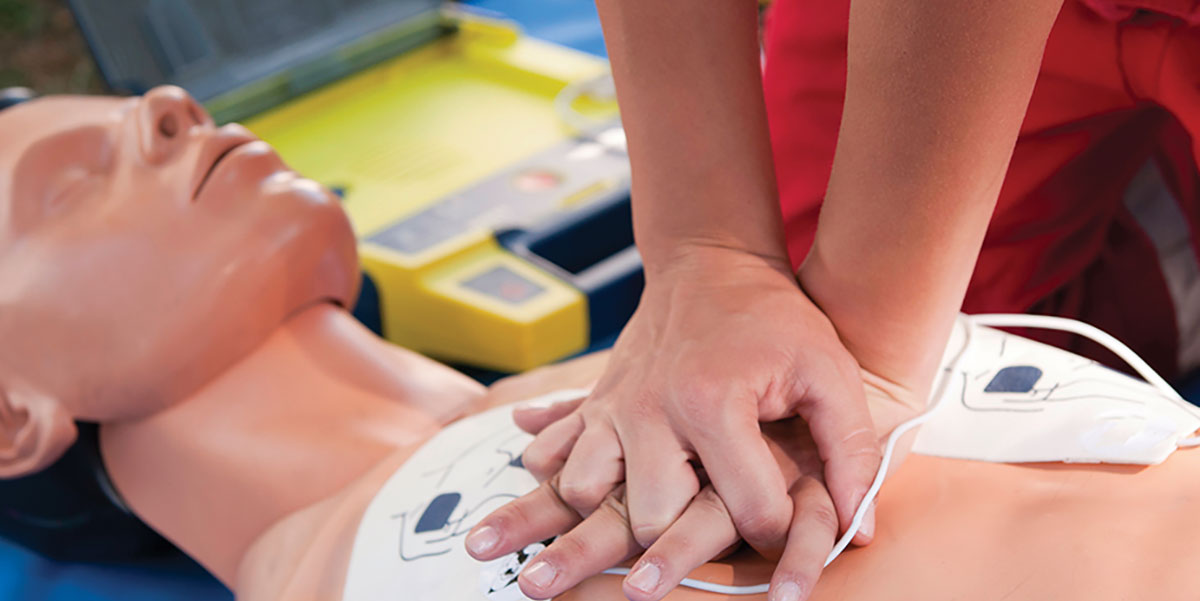
Summary of the key points in this guide
- The outlook for someone experiencing a sudden cardiac arrest (SCA) outside of a hospital is poor.
- Typically, only one in five (20%) will survive.
- Someone’s chances of survival significantly improve, to over 70%, if they can receive defibrillation within four minutes.
- An Automated External Defibrillator (AED) can be safely used without special training.
- An AED delivers a shock to help restore a regular heart rhythm to maintain an oxygenated blood flow to the brain and other major organs until medical help can arrive.
- Although there isn’t any requirement to have an AED in the workplace, one should be installed if your first aid needs assessment indicates that they are required.
- The availability of an AED in the workplace could help to save the life of an employee or someone nearby.
Automated External Defibrillators - frequently asked questions
Can a defibrillator start a stopped heart?
There is a misconception that the heart stops during a sudden cardiac arrest (SCA). In fact, it continues to beat in an irregular way called ‘fibrillation’, which prevents it from pumping oxygenated blood around the body to the brain and other organs. The AED provides a shock to defibrillate the heart and restore a regular rhythm.
How much does a defibrillator cost?
Prices can vary from a few hundred pounds to over £1,000. You will also need to consider the cost of mountings and cabinets, accessories and consumable items like pads and batteries.
Are AEDs dangerous?
Modern AEDs are very reliable and will not allow a shock to be given unless it is needed. They are extremely unlikely to do any harm to someone who has collapsed with a suspected SCA. They are also safe to use without training and will give you instructions.
Do AEDs need servicing?
AEDS run self-tests and will give a warning, normally a light on the front, if there’s a problem.
They include consumable items that will need replacing periodically or when they have been used.
The battery life of most AEDs is normally between three and five years.
The electrode pads generally have a shelf life of two to three years at which point they will need to be replaced, even if they have not been used.
If the pads are used on a patient your Ambulance Service might be willing to replace the pads, but you will need to confirm this with them.
